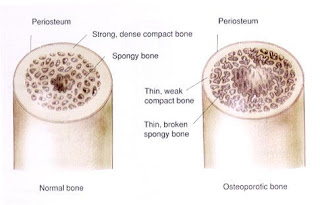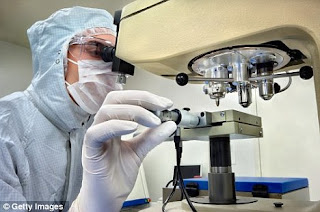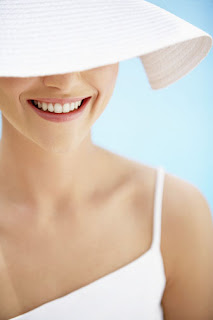*Research Shows Heat in Chili Peppers Can Ease Sinus Problems
Hot chili peppers are known to make people "tear up," but a new study led by University of Cincinnati allergy researcher Jonathan Bernstein, MD, found that a nasal spray containing an ingredient derived from hot chili peppers (Capsicum annum) may help people "clear up" certain types of sinus inflammation.
The study, which appears in the August 2011 edition of Annals of Allergy, Asthma & Immunology, compares the use of the Capsicum annum nasal spray to a placebo nasal spray in 44 subjects with a significant component of nonallergic rhinitis (i.e., nasal congestion, sinus pain, sinus pressure) for a period of two weeks
 Capsicum annum contains capsaicin, which is the main component of chili peppers and produces a hot sensation. Capsaicin is also the active ingredient in several topical medications used for temporary pain relief. It is approved for use by the U.S. Food and Drug Administration and is available over the counter.
Capsicum annum contains capsaicin, which is the main component of chili peppers and produces a hot sensation. Capsaicin is also the active ingredient in several topical medications used for temporary pain relief. It is approved for use by the U.S. Food and Drug Administration and is available over the counter. "Basically, we concluded that the spray was safe and effective on non-allergic rhinitis," Bernstein says of the study which showed that participants who used a nasal spray with Capsicum reported a faster onset of action or relief, on average within a minute of using the spray, than the control group.
Non-allergic rhinitis is an upper respiratory condition not caused by allergies but instead caused by environmental factors such as weather, household chemicals or perfumes; however, there are some people who have no triggers or don't know what triggers are causing the inflammation, Bernstein says.
This is the first controlled trial where capsaicin was able to be used on a continuous basis to control symptoms. It is considered a significant advance, "because we don't really have good therapies for non-allergic rhinitis," says Bernstein, adding that in previous trials the ingredient was too hot to administer without anesthesia.
So Chili is A Natural Products to Relieve Sinus Infections and problems effectively..
As the pepper heat helps to stimulate secretions that aid in clearing mucus from your nose, combatting nasal congestion. It also contains antibacterial properties that help fight chronic sinus infections.
Another Benefit for Chili Pepper .. Chili Peppers Help Lower High Blood Pressure
Eating chili peppers are naturally high in vitamins A and C, and also bioflavinoids. They help strengthen our blood vessels, which makes them more elastic and better able to adjust to blood pressure fluctuations. Chili peppers also can make us sweat, which causes fluid loss, temporarily reducing overall blood volume.
 Study leader Zhiming Zhu said that a clue to the possible beneficial effect of long-term chili consumption came from his own home region of Chongqing in south-west China.
Study leader Zhiming Zhu said that a clue to the possible beneficial effect of long-term chili consumption came from his own home region of Chongqing in south-west China. In his study, rats suffering from high blood pressure were given a long term diet containing capsaicin. The study found that capsaicin helped increase the production of nitric oxide in the blood. The gas is known to protect blood vessels against inflammation and dysfunction
This study isn't the first to look for a molecular link between capsaicin and lower blood pressure. But earlier studies were based on acute or short-term exposure to the chemical, with some conflicting results.

So far, there is no indication of how chili peppers could help humans, or how much chili you would need to eat to lower blood pressure.
And if you are one of those people who can't tolerate the effects of spicy foods such as chili, there may be some hope - a milder Japanese pepper contains a compound called capsinoid that is closely related to capsaicin.
"Limited studies show that these capsinoids produce effects similar to capsaicin," Dr Zhu said. "I believe that some people can adopt this sweet pepper."
Third Benefit is ...Chili Pepper Can Help You Burn Fat and Lose Weight
Did you know that capsaicin is a thermogenic? Thermogenics stimulate the body's burning of fat byincrease the metabolism of the body's adipose tissue, generating heat. So many of us can stand to shed a few pounds and lose some unwanted extra weight, so a smart and healthy move is to drop the fatty foods and replace them with some chili pepper spice, along with the inclusion of regular exercise, of course.
chili and peppers increase your metabolic rate by almost 50 percent for three hours after eating. The spice increases your heart rate and gets your metabolism moving faster
''We found that consuming red pepper can help manage appetite and burn more calories after a meal, especially for individuals who do not consume the spice regularly," said Richard Mattes, distinguished professor of foods and nutrition who collaborated with doctoral student Mary-Jon Ludy. "This finding should be considered a piece of the puzzle because the idea that one small change will reverse the obesity epidemic is simply not true. However, if a number of small changes are added together, they may be meaningful in terms of weight management. Dietary changes that don't require great effort to implement, like sprinkling red pepper on your meal, may be sustainable and beneficial in the long run, especially when paired with exercise and healthy eating."
Other studies have found that capsaicin, the component that gives chili peppers their heat, can reduce hunger and increase energy expenditure -- burning calories. The amounts tested, however, were not realistic for most people in the U. S. population, Mattes said.
This study found that those who did not consume red pepper regularly experienced a decrease of hunger, especially for fatty, salty and sweet foods.
"The appetite responses were different between those who liked red pepper and those who did not, suggesting that when the stimulus is unfamiliar it has a greater effect. Once it becomes familiar to people, it loses its efficacy. The finding that there is a difference between users and non-users is novel and requires further study to determine how long it will be effective and how to adjust the diet to improve continuous effectiveness."
* Forth Benefit ... Chili Peppers Help Protect Your Heart
 Capsaicin may help to protect the heart by reducing cholesterol, triglycerides and platelet aggregation. It may also help the body dissolve fibrin, which is necessary for blood clots to form. Further, cultures around the world that use hot peppers liberally in their meals have significantly lower rates of heart attack and stroke than cultures that do not.
Capsaicin may help to protect the heart by reducing cholesterol, triglycerides and platelet aggregation. It may also help the body dissolve fibrin, which is necessary for blood clots to form. Further, cultures around the world that use hot peppers liberally in their meals have significantly lower rates of heart attack and stroke than cultures that do not. 












































